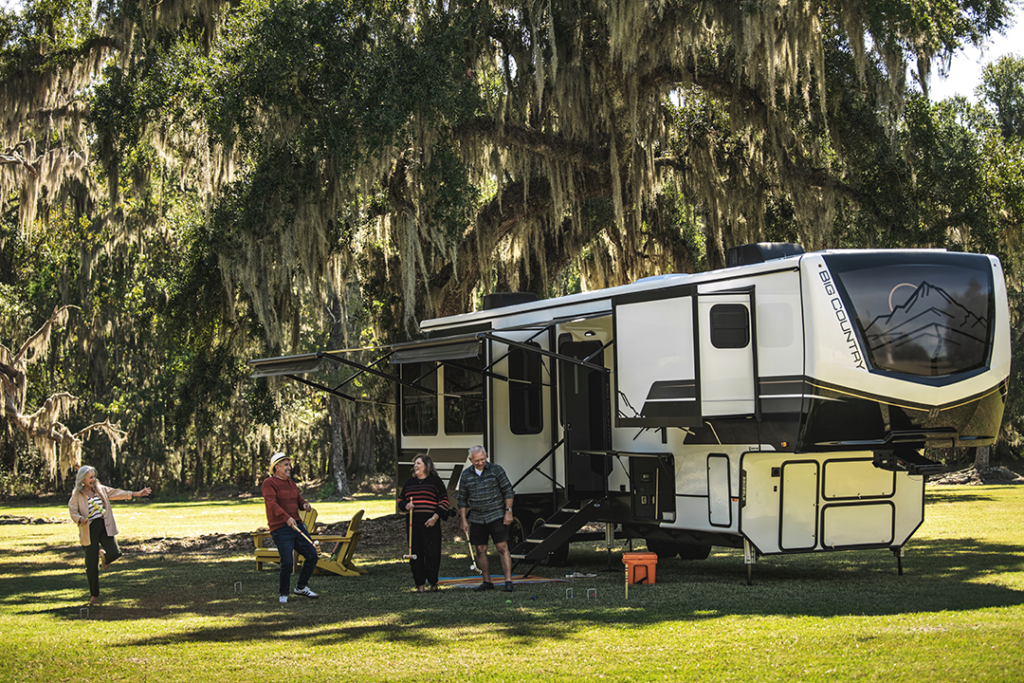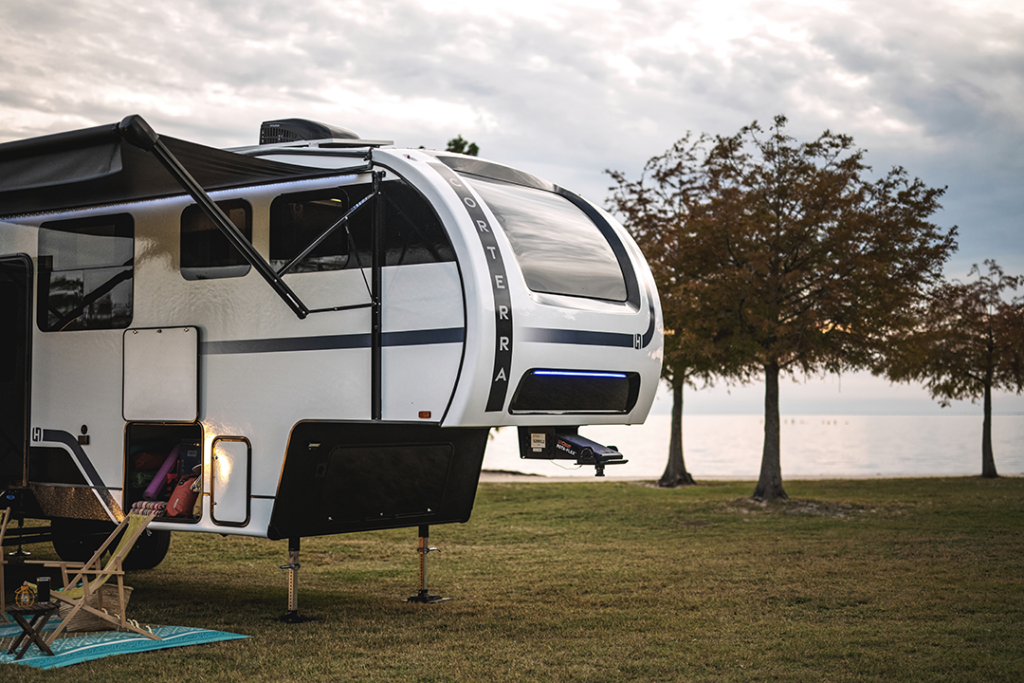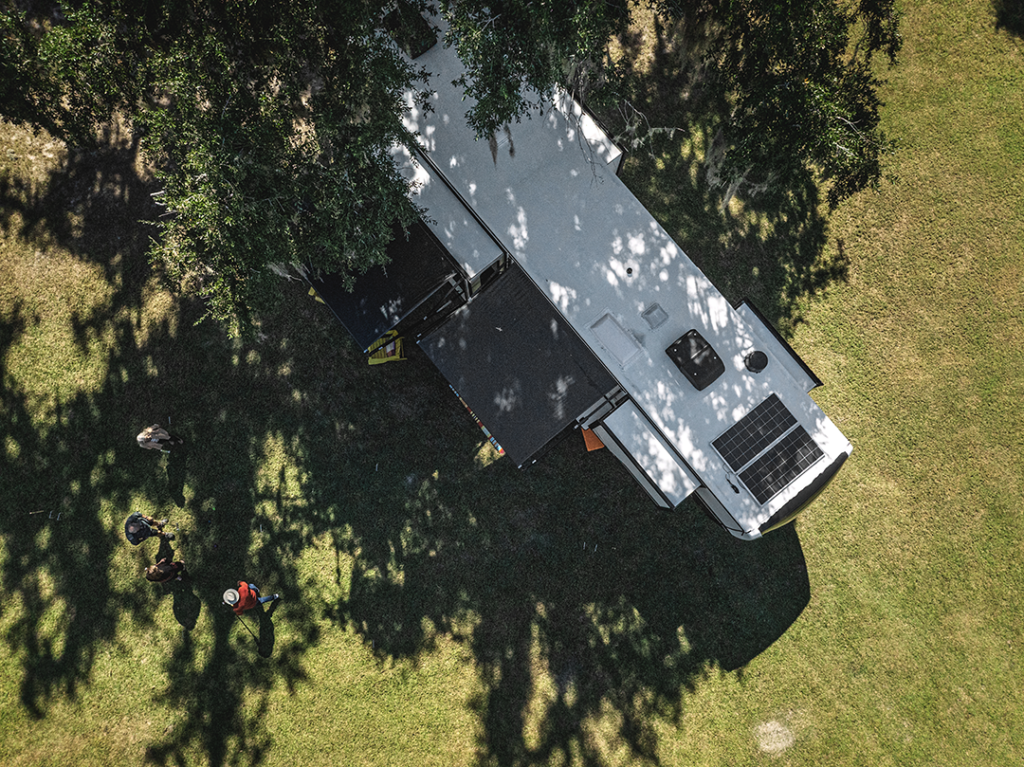The Best Way to Wash and Maintain an RV Exterior
When buying an RV, you'll be driving it off the lot with dreams of camping trips for years to come. To extend the life of any coach, an essential of RV ownership is keeping the exterior washed, clean and free from damage. As the front line against the elements, the exterior of your RV protects against leaks, drafts, and excess heat so you can camp comfortably and without issue.
So keeping your exterior clean is vital. But what should you use to clean it? Many commercial cleaners and tools are too harsh and rough for RV exteriors. These products can damage the finish, dry out seals, and leave scratches that make your coach look old ahead of its time.
That’s why we’re walking through the best ways to clean and maintain the outside of an RV. With a few simple considerations, you can keep your rig sparkling and looking good through many camping seasons. Here’s the best way to wash and maintain an RV exterior.
Why is it Important to Clean and Maintain My RV Exterior?

Just like your car or truck, your RV collects grime out in the world. Unless it’s in storage or under a cover, your RV experiences constant exposure to UV rays, rain, dust, pollen, bird droppings, tree sap, road tar, and more. When these sticky, corrosive, or abrading elements sit on the surface of your RV, they can eat through finishes, attract more debris, and even gum up the works of your slides and roof-mounted features like air conditioners and fans.
So washing your RV exterior clean isn’t just a matter of making it look nice. It’s a way to remove harmful elements before they can damage your RV in annoying and expensive ways.
What Tools and Products Do I Need to Wash My RV Exterior?
When it comes to cleaning your RV, you want to choose tools and cleaners that are mild and gentle. Cleaning agents should be mild to protect the more easily damaged elements of your RV, like awnings and seals. The tools you use should be the gentlest versions that still get the job done to keep from accidentally scratching or gouging your RV’s finish. They should also be able to reach the tops of slides and the corners of the roof without too much effort.
Tools and Cleaners to Use to Wash Your RV
Here are some items you may want to purchase to wash your RV:
- A soft-bristle brush with an extending handle
- Microfiber cloths
- Soft sponges
- Buckets to hold soapy and clean water
- Hose with a multi-pressure sprayer
- Chamois cloth for drying
- Gentle automotive or RV cleaner or soap and water
- Window squeegee
A soft-bristle brush with an extending handle will help you clean hard-to-reach places without reaching or leaning and losing your balance. Microfiber cloths and soft sponges let you wash your RV while being gentle enough not to cause damage to paint finishes, fiberglass, decals, seals, and other sensitive surfaces. Buckets are handy for holding both soapy and clean water while you wash.
If you have access to a hose, look for a multi-pressure sprayer head so you can adjust the water flow to suit your needs. Too much pressure can cause damage–a wide, moderate spray is just right. A chamois cloth is the perfect rag for drying your RV, while a squeegee can leave your windows streak-free.
When it comes to cleaning agents, choose between a gentle RV cleaner approved for use on fiberglass or mild soap and water. But always be sure to check your own owner’s manual to ensure the cleaner you use is suitable for your RV, and always check the bottle of any products to ensure they’re safe to use outdoors where they’ll wind up in the ground.
How to Wash Your RV Exterior
To wash your RV exterior, find a shaded place to park so your soap doesn’t dry out before you can rinse it off. Start cleaning at the top and move to the bottom so grime flows down and doesn’t contaminate already-cleaned areas.
With a bucket of soapy water or diluted cleaner, wash your RV with a soft sponge or cloth, taking care to remove any stubborn debris stuck to the surface. Work in smaller sections rather than trying to wash the entire RV at once. Use a soft brush to scrub any hard-to-reach areas like the tops of slides and the roof, and be sure to flush the underbelly with water to clean road salt and dirt off the underside of your coach. If you have a hose, you can spray the soap off to rinse, but don’t use a spray setting with a lot of pressure. It’s better to coax debris off with a soft cloth than blast it off with a pressure washer.
Because RVs can collect a lot of grime, swap out the water in your bucket a few times throughout the process. As you wash, inspect your RV for damage on seals around slides, windows, and doors, on the roof, and on the awnings. When seals deteriorate, they can cause leaks and water damage, so always repair or replace damaged seals right away.
When you’ve washed an area, rinse it with clean water from a hose or bucket. You can dry the exterior with a chamois cloth to prevent water spots and dry windows with a squeegee to get a perfect finish.
Should I Wash My RV Awnings?

You may not need to wash your RV awnings every time you clean your RV. Often, rinsing them with water is enough to keep them clean. But if you’ve been camping in an area where tree sap or bird droppings have been accumulating on your awnings, use your soft brush to gently scrub them clean with water.
If you use a cleaning agent on your awnings, make sure to buy something specifically designed for them. Many commercial cleaning products contain harsh ingredients that can degrade the fabric or fade the color. Awning cleaners are formulated to be gentle while still getting them clean.
After you wash and rinse your awnings, be sure to let them dry completely before retracting them. Trapped moisture can make mold grow on the fabric.
Where Can I Wash My RV?
The most obvious place to wash your RV is on your own property, but not everyone has that kind of space at home. Most campgrounds won’t allow you to wash your RV at your campsite, so your best bet is to look for a truck wash or self-serve car wash along your route.
Do I Need to Wax My RV Exterior?
RVs built with fiberglass exteriors can benefit from the occasional coat of wax to help protect the surface. Consult your owner’s manual for guidance on timing. At Heartland, we recommend waxing and buffing all gel-coat surfaces once every six months with a product formulated specifically for fiberglass.
Should I Do Anything Special for My Wheels and Tires?
While you don’t need to use any special products to clean your wheels and tires, we recommend using RV wash day as an occasion to check their condition. Look for any signs of damage, like cracks, worn-down treads, and rust. You should also check your tire condition and pressure before every trip.
The average lifespan of trailer tires is five years with normal maintenance and use, and tires age whether you’ve been driving on them or not. So be sure to check your tires for degradation even if your RV has been in storage for several months, and build new tires into your budget every five years or so.
What's the Best Way to Wash My RV Roof?

Safety is the most important consideration when it comes to washing your RV roof. Make sure you know whether or not your specific RV model has a roof you can walk on, and don’t walk on roofs that aren’t built for it. A long-handled soft brush can help clean hard-to-reach areas instead. And of course, while you’re washing your roof, take a look at all the seals and repair any that are cracked or crumbling to prevent leaks and water damage.
Although washing your RV can be a big project for one person, we happen to think asking kids to help out is a great way to do the work faster, have some fun, and teach kids about the satisfaction of taking care of valuable possessions. (And kids love to spray water, don’t they?)
If you want to read more tips about RV upkeep, check out our RV maintenance checklists broken down by how often you should perform them. With a little elbow grease, you’ll keep your RV looking good and functioning optimally for years to come.





